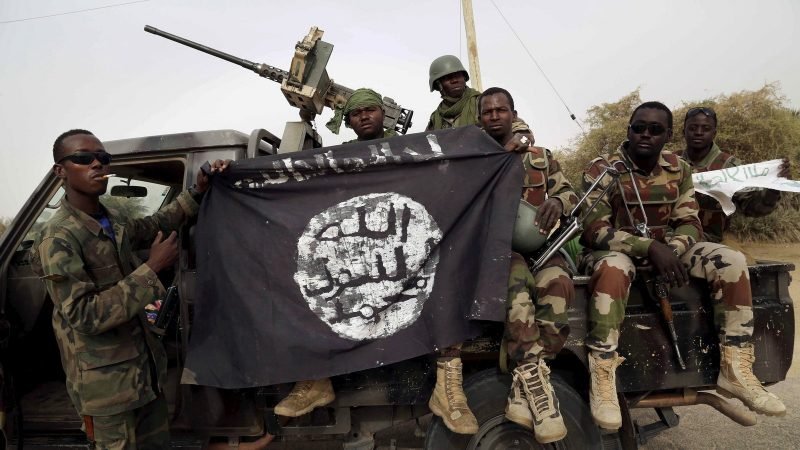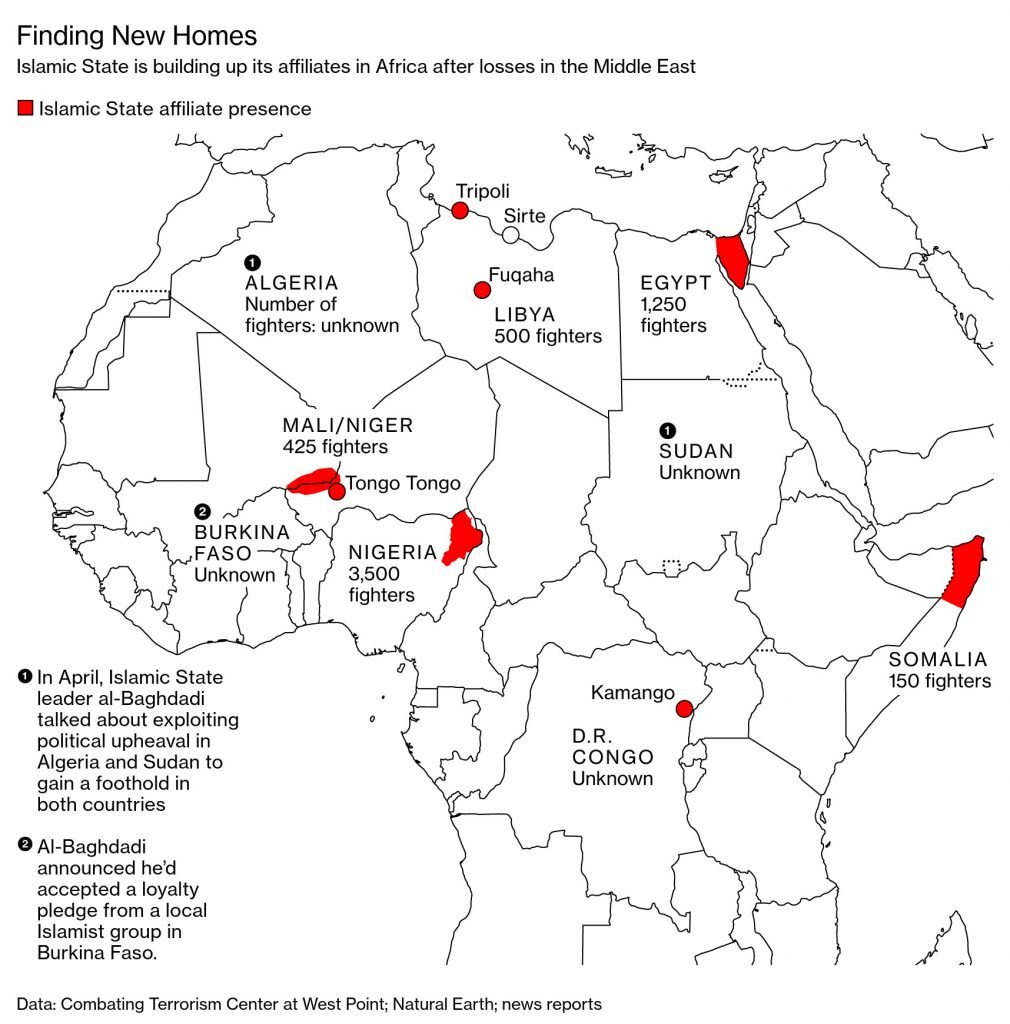Understanding the Emergence of the Islamic State in Africa

The Nigerian military announced on Friday 25th September that 18 people were killed after an ambush on a government convoy in the north-east of the country. According to the sources, 10 police officers, four soldiers, and four civilians were killed in the attack that targeted Borno State officials. Initially, Boko Haram claimed that they were behind the attack however after much interrogation it was stated that Islamic State to which Boko Haram pledged alliance was behind this. The Islamic State also claimed that they were responsible for the attack and stated that 30 people had been killed. The military has been fighting against the Islamist militant prevalent across different parts of the continent. In early 2019, the Islamic State was declared defeated after it was trounced by the coalition-backed by the Syrian Democratic Forces (SDF) in the town of Baghouz in eastern Syria. The recent attacks by the Islamic State thereby prove that they have not been defeated rather are operating under various names across the African continent.
The Rise of the Islamic State in Africa
Towards the end of 2016, Abu- Bakr al- Baghdadi, leader of the Islamic State of Iraq and Syria declared that the faction had extended and moved some of their activities to Africa. According to the “Dabiq”, the magazine published by the Islamic State mentioned regions of Africa that were part of its caliphate and the regions included Chad, Sudan, and Egypt. In September 2014, Algeria became the first state were the African Islamic State affiliate was born. One month later, the Shura Youth Council comprising of 300 fighters, primarily Libyans who fought in the Battar Brigade in Syria’s civil war, pledge allegiance to the Islamic State. From 2014 to 2016, large Islamic State “Cells” or “Wilayat” as it is popularly known emerged in different parts of the African continent.
Although the emergence of these cells has raised concerns in its own right, they have received much attention in late 2017 after the collapse of their traditional caliphate setting in Syria and Iraq. The Islamic State is active in different provinces and is named accordingly. For instance, Islamic State West Africa Province (ISWAP), Islamic State Central Africa Province (ISCAP), Islamic State in the Sinai Province and Islamic State in Maghreb.

Islamic State West African Province
Since its formation in 2009, Boko Haram under the leadership of Abubakar Shekau became popular for its brutal insurgency in West Africa and its abduction of Chibok girls in 2014. Boko Haram pledged allegiance to the Islamic State and in this context, the Islamic State West African Province was established. This alliance received a lot of criticism from the international community and was referred to as “Marriage from Hell”. By 2016, tensions between Islamic State Central and ISWAP became visible and soon Shekau was swapped with Abu Musab al-Barnawi, the son of Boko Haram’s founder, Mohammad Yusuf. Shekau and some of his loyal fighters continue to carry out their operations under the banner of Boko Haram. It took several months for the ISWAP to rebuild its strength and execute its activities. In March 2019, Abu Musab was replaced by Abu Abdullah al-Barnawi but unlike Sheakau, Barnawi did not form his independent faction.
Currently, the ISWAP led by Barnawi is operating in the Lake Chad Basin region while Boko Haram under the leadership of Shekau is active near the Sambisa Forest further south. Boko Haram is sometimes referred to as the second branch of ISWAP. In terms of membership, the report published by the UNSC, there were 3500 members affiliated to the Barnawi faction. To add further, the ISWAP faction is the largest Islamic State grouping in Africa.

Islamic State Sinai Province
Following ISWAP, Islamic State in Sinai Province is the second-most active group affiliated to the Islamic State. ABM or Ansar Beit al-Maqdis also popularly termed as “Supporters of Jerusalem” is an Egypt-based insurgent group created in the aftermath of Hosni Mubarak’s upheaval as president during the Arab Spring. The ABM initially declared itself as al-Qaeda’s wing in the Sinai Province however it was never officially affiliated to al-Qaeda and in 2014 it declared allegiance with the Islamic State. After conducting a range of attacks against Israel during the conflict in Gaza the group shifted its focus back on Egypt. As per the sources, Egypt was the single-country in Africa where the majority of the attacks reported were carried out by the Islamic State.
The Islamic State in Sinai Province is said to be closely associated with the Islamic State Central when compared to the other African groups affiliated to the central force and it is also believed that ISSP receives a huge number of weapons, training, and funding from the Islamic State. The ISSP generally reports a similar amount of activity to that of ISWAP but the intensity of their operations has been comparatively lower. The number of fighters in ISSP is approximately 1000 to 1500 and post its alliance with the Islamic State the number has comparatively surged up. The most striking feature of ISSP is that the number has been consistent and the group has become much more active as compared to the past.
Islamic State in Libya, Algeria, and Tunisia Province
Along with Sinai and West Africa Province, the Islamic State has been active in Libya, Tunisia, and Algeria. Especially Libya has been a popular destination for the Islamic State and no other Islamic State affiliate in Africa has garnered as much concern as the Islamic State in Libya. In 2014, Algeria and Libya emerged as provinces (Wilayat al-Tarablus, Wilayat al-Fezzan, and Wilayat al-Barqah). The Libyan province was clubbed into one in 2018 and the Algerian province became obsolete post some operational activities. In the case of Tunisia, provincial status was never conferred upon it.
In 2019, the Islamic State claimed one attack in Algeria, one in Tunisia, and eight attacks in Libya. In terms of targets, the majority of the attacks carried out by the Islamic State were to strike down military assets. However, as compared to the Islamic state operating in different countries in Africa, The Islamic State in Libya is said to have taken a back foot. Though thousands of recruits have been taken from Tunisia, The Islamic State has not taken a strong stance on its presence and a result of which the activities in Tunisia has been comparatively low. Similar is the case in Algeria were the intensity of operations has been less and the small active support base mainly confined to remote parts of the country is the prime reason behind this.
Along with this, the Islamic State has been active in Somalia and Central Province.

Current Scenario
In the last one year, the activities of the Islamic State have increased significantly and many countries across the African continent have raised concern over the growing presence of the Islamic State. Along with training, funding, and theological guidance, The Islamic State has emphasized on reorganizing the ISWAP and the other factions. The objective of the Islamic State continues to remain the same and the group’s affiliates in Africa have set up bases in regions with a prolonged economic crisis, security instabilities, tremendous socio-economic problems, and poor governance. The main attraction for the Islamic State within Africa is not its resources but is about its reputational and ideological potency. While its main aim in Syria and Iraq was to control the Arab world and create a utopian government model.
Though the presence of the Islamic State has become evident in West Africa and Greater Sahara regions and its development needs to be kept a track of but insurgent groups such as Boko Haram and Al Shabaab pose a greater threat as they are well-grounded in the local communities and they are not depended on the Islamic State for operational guidance or funding. Furthermore, the militant group in Africa has shown reverence to Wahabi teachings. From early 2020, the Islamic State in Greater Sahara has increased its attacks on the military groupings in Mali. Taking this condition into account, the Pau summit was organized by France and G5 Sahel Group in January 2020 and the Liptako-Gourma region was identified as a priority area. More and more factions are getting affiliated to the Islamic State and their activities are expanding across different regions.
Various factors have contributed to the growing presence of the Islamic State. Primarily, the low participation of Al-Qaeda in the Sahel region, mainly after the increase in defections in the ranks of the JNIM organization, which announced its willingness to negotiate with the Malian Government. Secondly, the growing dominance of the Islamic State over its branches in the African continent, particularly after the execution of the leaders of ISWAP uniting with al-Qaeda. Thirdly and most important factor is merging the geographically contiguous African units mainly ISWAP and ISGS. This merging technique has helped the faction to carry out their activities in a more organized manner.

Way Forward
The merging of the different branches has increased the intensity of threat as this unification will open new frontiers for carrying out their activities. Thus, a collaborative strategy must be implemented to counter the different branches affiliated to the Islamic State. Joining hands with the external players will be beneficial in this fight against terrorism. Though many of the African countries have announced that they would carry out joint military operations to counter-terrorism, the current political and economic situation is a major challenge obstructing the counter-terrorism efforts on the African continent. Meanwhile, it is important that along with addressing the internal changes the external challenges should be monitored. Therefore, it will be interesting to see how the African countries come together to counter this challenge that has acted as a barrier in their development journey.


















